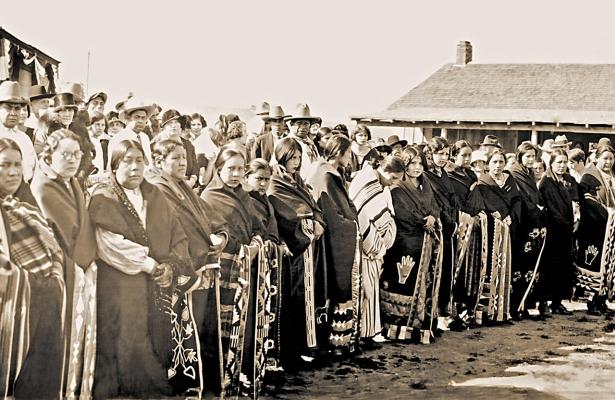When the World War I veteran Ernest Burkhart (played by Leonardo DiCaprio) gets off the train in Osage County, Oklahoma, he is walking into the turn-of-the-century boomtown of Fairfax, a bustling throng of activity that has sprung up out of nowhere following the discovery of oil. Wandering salesmen press leaflets into his hand and promise he can get rich quick; luxurious automobiles buzz around, the atmosphere pulsing with a feeling of runaway success. But as Burkhart is driven by an Osage man named Henry out to the countryside through fields of pumping derricks, he asks whose land he’s on. “My land,” Henry says gruffly.
As it thrusts the viewer into this epic tableau, a world of sudden and overwhelming wealth at the start of the 20th century, Martin Scorsese’s Killers of the Flower Moon is suffused with the dreadful sense of storm clouds gathering on every horizon. Adapted from David Grann’s best-selling book, the film explores the history of the Osage Nation as it reaped the rewards of oil residing underneath its land and immediately found itself in the crosshairs of an overwhelming force: pioneering American exceptionalism, which Scorsese demands that the viewer recognize as brutal white supremacy.
Grann’s masterful book is preoccupied more with the investigation of the notorious Osage murders, a series of mysterious deaths that diverted much of the tribe members’ money to white family members who had married into their oil rights. The quantity of murders was shocking enough to summon the predecessor of J. Edgar Hoover’s FBI, whose lawmen helped unravel the evil conspiracy behind the killings. But that whodunit is mere window dressing to Scorsese’s film, which he co-wrote with Eric Roth; the filmmaker’s fascination lies more with Burkhart, who married an Osage woman named Mollie (the remarkable Lily Gladstone), and the terrible contradictions contained within their marriage.
The history is clear on who perpetrated the Osage murders, and within minutes of meeting the local cattle magnate William Hale (Robert De Niro), Ernest’s uncle, viewers will pick up on something deeply sinister afoot. But over the course of three and a half entirely gripping hours, Scorsese plumbs what he clearly considers the biggest enigma of the tale—whether there was real humanity to relationships like Ernest and Mollie’s, despite the evil intent behind them. It’s a conceit that would fail without the staggering work being done by DiCaprio and Gladstone, who depict a sometimes loving but deeply poisonous partnership that reflects the slow-moving scheme around them.
In focusing on a doomed partnership rather than on white-hatted FBI agents saving the day, Scorsese pays homage to the swooning, romantic roots of classic Western films, which often depicted star-crossed love, Native Americans as a mysterious other, and fated heroism. But Killers of the Flower Moon scrubs the Old Hollywood varnish from cowboys like Ernest to reveal them as they truly were: crude and callous “pioneers” whose only motivation was to seize more of what they felt belonged to them, be it money, land, or women. Ernest happily regards himself as a simple creature, fond of drink and sex, and when he’s pushed into courting Mollie by Hale, he does it with the same dunderheaded aplomb with which he later carries out far more nefarious deeds.
He’s just one of many blunt instruments deployed by Hale, a rancher and political boss who presents himself as a friend of the Osage—he speaks their language, knows their customs, and breaks bread with them constantly. The most terrifying thing about Hale is that he clearly believes his own guff. De Niro plays him as a chummy, satisfied grandpa, nudging Ernest and Mollie toward each other with glee while also matter-of-factly telling Ernest that the Osage, as a people, are clearly on their way out from civilization, and white men are rushing in to replace them. The banality of Hale’s malevolence, combined with the sheer scale of his manipulation, is almost too staggering to consider—so. DiCaprio doesn’t let Ernest do it, portraying him instead as a simple cowboy going with the flow.
It’s up to the audience to piece together how self-aware Ernest is, and how long it takes him to comprehend the depth of what’s happening. Similarly, it’s easy to identify with Mollie’s initial reaction of being charmed by this dashing outsider, and her unwillingness to accept that he might be part of the malice being inflicted on her family and her people. From the start, white society is obviously hell-bent on usurping the surprising wealth and influence of the Osage, but Scorsese still depicts the criminality beat by beat, each individual death here and there piling up into a generational tragedy.
Eventually, the FBI (or, technically, its forebear, the Bureau of Investigation) does show up, in the guise of Tom White (Jesse Plemons), a straight-arrow investigator who starts asking hard questions of Hale and Ernest. But again, Scorsese is least interested in the actual detective work involved. He’s invested more in the tragic consequences of these deaths, pushing his viewer to understand that whatever justice might have been done on behalf of the Osage, it was not nearly enough to halt the larger, inevitable act of ethnic cleansing that had already been happening for hundreds of years. Scorsese will frequently visit old Hollywood genres he adores, like the gangster film or the costume drama, and use their tropes to examine life as it really was at a particular time, unearthing grimy realism in filmic slickness. As a Western, Killers of the Flower Moon does exactly that, taking in swelling vistas of Oklahoma before probing the rot just beneath the surface. It’s a tremendous but chilling achievement from one of America’s great storytellers.


Spread the word